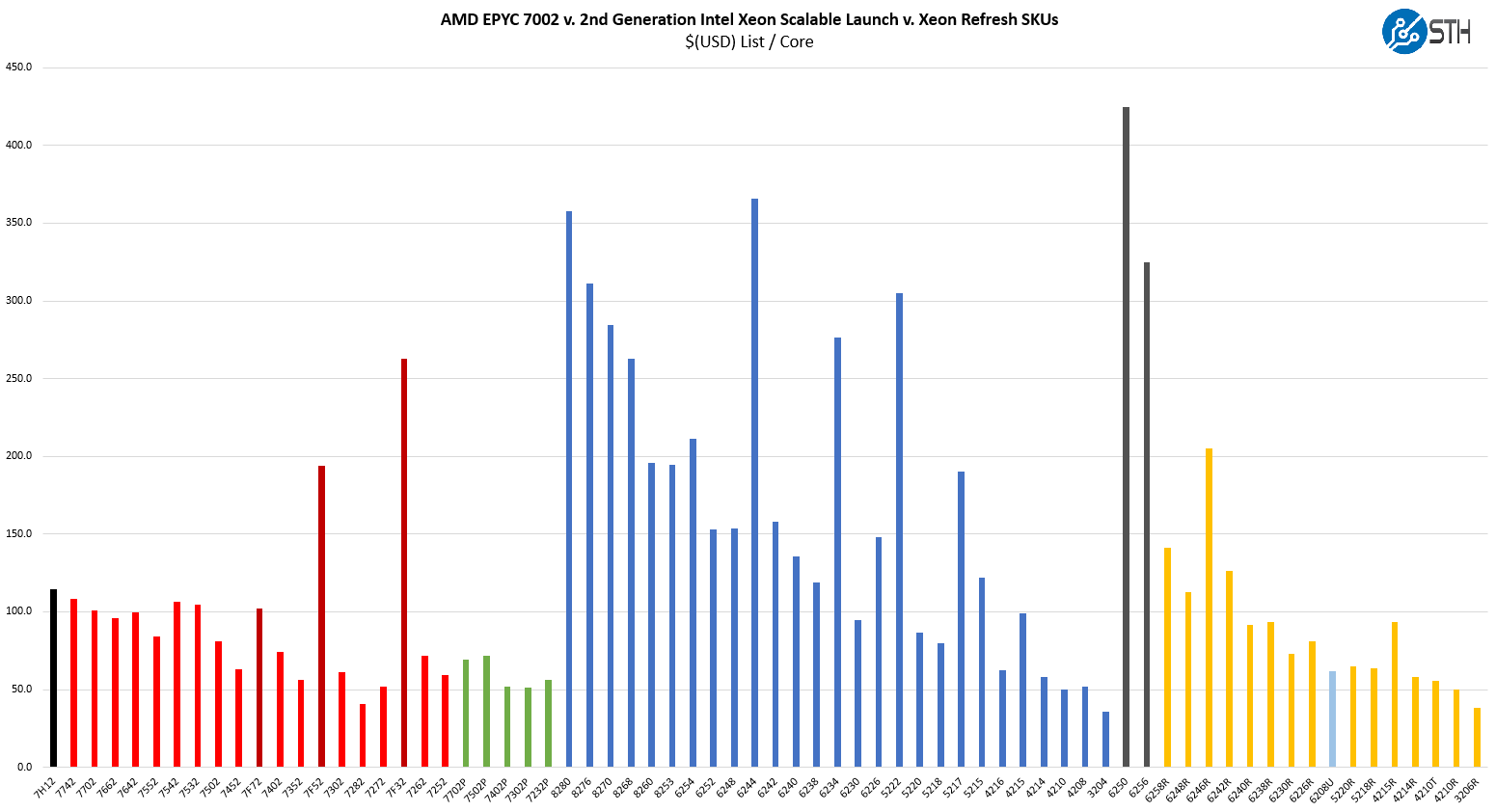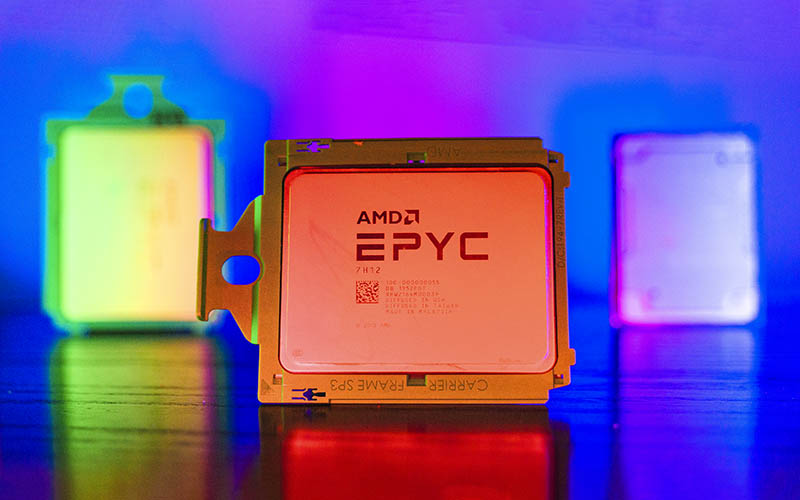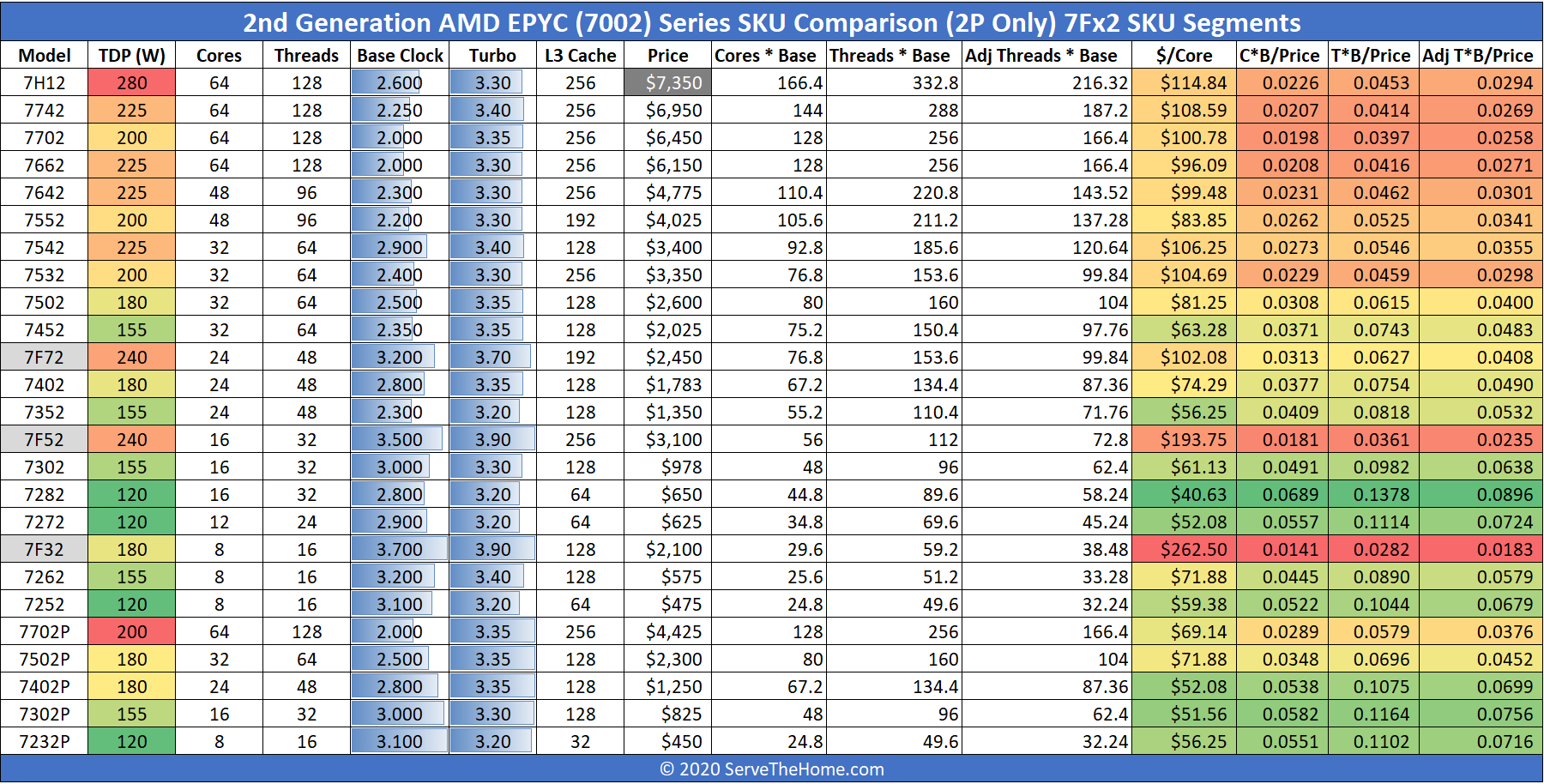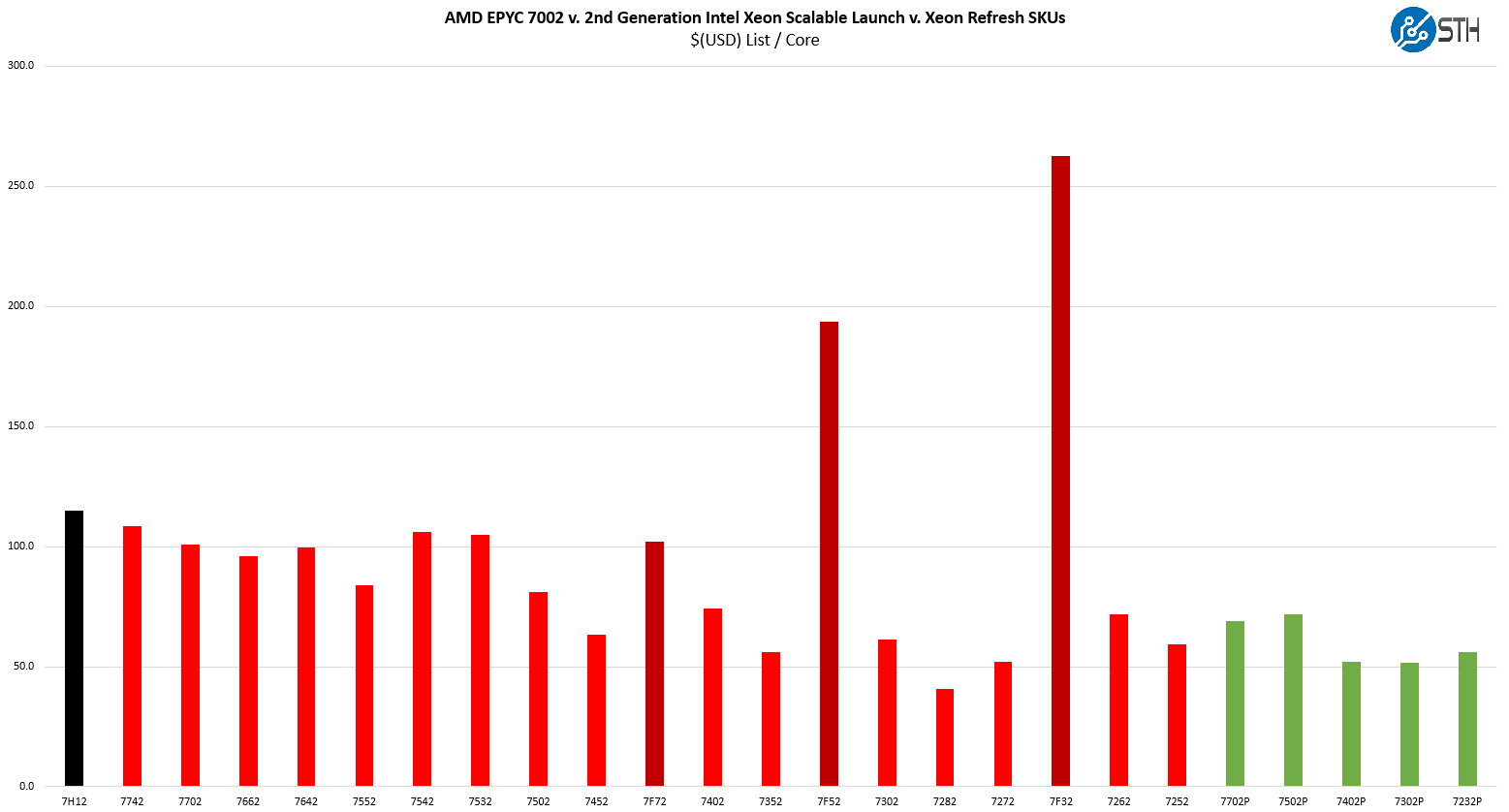AMD EPYC 7H12 Market Positioning
These chips are not released in a vacuum instead, they have competition on both the Intel and AMD sides. When you purchase a server and select a CPU, it is important to see the value of a platform versus its competitors. We are going to first discuss AMD v. Intel competition then look to AMD v. AMD.
AMD EPYC 7H12 v. Intel Xeon
Taking a step back, here we have the main segments of the AMD EPYC and 2nd Generation Intel Xeon Scalable (plus refresh) processors on a $(USD) List per core basis:

Perhaps the strangest takeaway here is that AMD is effectively offering its highest-end part at a per-core discount to the 2nd generation Intel Xeon Scalable Refresh SKUs. If we look at the original 2019 SKUs (blue) and the refresh SKUs (gold) we can see how much Intel has moved its SKU stack to match AMD. What we can also see is that AMD is pushing Intel very hard at the top end.
Something that is important and non-trivial is that the AMD EPYC 7H12 may be too much processor for modern systems. We now have Licenseageddon Rages as VMware Overhauls Per-Socket Licensing along with other per-core licensing schemes in the market. Other segments focus on memory bandwidth per core where having fewer cores with the same 8-channel memory bandwidth is preferable. We also have the fact that adding 64-cores to a system will create too big of a “blast radius” for smaller installations should the system go down.
The other side to this is that in a 2U server configuration, the cost of the CPUs can be relatively small. This may seem foreign on the consumer side, but we have a $116,000 (list price/ $73,000 with customary discount) configuration that has around $14700 in CPUs. These CPUs are only around 13% of the server’s list price. The rest goes to the system but also components such as RAM, storage, networking, and accelerators. Saving $7000-8000 (pre-discount) for an Intel Xeon Gold 6258R versus an AMD EPYC 7H12 equipped system is still a notable sum, but when one can often see more than twice the performance, that price differential is dwarfed by the consolidation factor.

AMD offers a larger memory footprint with up to 4TB in 8-channel DDR4-3200 versus 1TB in 6-channel DDR4-2933. AMD has more PCIe I/O with 64, 96, or 128 PCIe Gen4 lanes per socket compared to Intel’s 48x PCIe Gen3 lanes. Intel has features such as AVX-512 and VNNI instructions (DL Boost) that AMD does not have but are new for 2nd Generation Intel Xeon Scalable. Perhaps the biggest feature Intel has is Optane DCPMM support. We should note here that DCPMM support is limited by memory capacity since the Gold 6258R is not an “L” SKU. If you want high-memory support you are still looking at a Xeon Platinum 8280L at over $13000 list price which is hard to justify with the 7H12. Still, if one wants fast storage, DCPMM is a significant option that AMD does not have. If you are not using small DCPMM footprints, nor the new instructions, then AMD is extremely competitive.
Again, if we look at raw performance numbers, then the AMD EPYC 7H12 should sell like hotcakes if AMD ever pushed that solution harder. In reality, there are other market forces that suppress demand for these high-end 64-core parts. To Arm vendors out there, the AMD EPYC 7H12 is effectively the 2019 chip to beat if you are looking at top-end performance and forgetting power consumption.
AMD EPYC 7H12 v. AMD
Here is what the current AMD EPYC 7002 “Rome” offerings look like. We are going to use the higher-end of the range AMD gave us so adding $400 to the EPYC 7742’s pricing to use a plug for the EPYC 7H12 here.

Perhaps the nice thing about the AMD EPYC 7H12 is that it is an almost outlandish part in today’s environment. In many ways, it is not special. We know that raising the TDP of an AMD EPYC 7742 increases performance. That is certainly what is happening here.

What is very different is that AMD is extracting a small premium for this. The AMD EPYC 7H12 is only a few dollars per core more than the EPYC 7742. That is only part of the equation. As mentioned earlier, since we are using two different 2U platforms, giving exact power figure differences is not really a valid exercise. We stripped the systems down and the best guess is that the AMD EPYC 7H12 can have a 55-85W impact on a system’s at-the-PDU power consumption per socket. That includes cooling which is a non-trivial piece of comparing a 225/240W TDP CPU to a 280W TDP CPU. As a result, the EPYC 7H12 system in our own TCO planning for our labs would be a $250-350/ year or so impact in operating costs if we assume the 2U baselines.
To our readers, get ahead of your peers and look for the EPYC 7H12 offerings in 2U systems. If your server vendor offers 280W TDP support, and a relatively small increase in cost to get the additional performance, then it may be a worthwhile upgrade. That, of course, assumes that you are in the market for an AMD EPYC 7742.
Final Words
Looking ahead to 2021, we are going to have AMD EPYC 7003 “Milan” processors as well as Intel Ice Lake Xeons. We are expecting major volume shipments of both to ramp in Q1/Q2 2021 with AMD likely ahead, but Intel should be shipping Ice Lake Xeon systems by now or in the next few weeks to early access customers. We already know that Zen 3 offers a large IPC increase which will make Milan formidable, especially with a “7H13” style part. Here are some of the current market dynamics from our The 2021 Intel Ice Pickle How 2021 Will be Crunch Time piece:
In Q4 2020 or Q1 2021 if you are a STH reader, and you are looking at 64 core EPYC processors, look at the EPYC 7H12. There are rack-level reasons from a power and cooling standpoint, as well as simply the prospect of putting 64 cores in a single-socket reasons that you may not ultimately go with the EPYC 7H12. At the same time, if you are an STH reader, it would be wise to ask about the EPYC 7H12 before the broader market catches onto the solid pricing.




Impressive! Thanks Patrick. I wonder how soon you will be measuring Linux kernel compiles per second.
We actually use a larger codebase to compile than some others. When we started, I thought that it may be too big, especially for embedded chips. Now I am looking for what is next that is larger.
Chromium or Firefox are pretty large in LoC/Compile time but the build can be a bit finicky.
GCC is large too, might be an option.
Tensorflow takes ridiculously long to compile in my experience, too.
Building LLVM takes a while and Qt 5.15 takes ages.